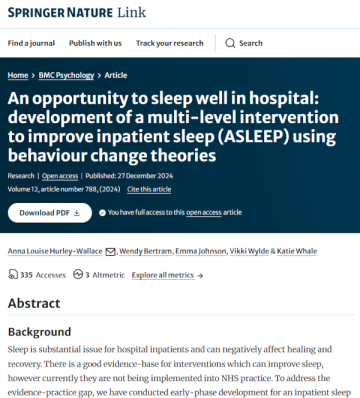Improving sleep for inpatients on surgical wards
Theme Surgical and orthopaedic innovation
Workstream Interventions to improve patient outcomes after surgery
Status: This project is complete
The aim of this project was to design an intervention to improve how patients sleep while they are in hospital. The project had three parts: a review of existing evidence, a national survey of NHS ward staff, and NHS staff stakeholder engagement.
What we did
Review of existing evidence
We looked at published papers of approaches for improving patient sleep in hospital to understand what has already been done and how effective it is. We then showed our results to a patient and public involvement group of patients with experience of overnight stays in hospital to find out which approaches are most acceptable.
National survey of ward staff
We conducted a survey of ward staff from across the UK to find out:
- Their views about patients’ sleep quality on wards
- What the sleeping environment is like on wards
- Current strategies they use to improve patient sleep (if applicable)
- Barriers that stop patients improving their sleep on wards
- Their suggestions for improving how patients sleep
From the results of survey we identified barriers to facilitators to sleep well in hospital. We then applied health psychology and behaviour change theory to identify which factors it is possible to change, and what support would be needed to make these changes successful.
NHS staff stakeholder engagement
We met with senior ward staff and managers to review the areas for change, understand the feasibility of making changes on the ward, and identify any barriers to change.
What we found and what this means
We found 18 factors that could be changed to improve sleep for patients. These were grouped into three areas: ward environment and equipment, staff awareness and behaviour, and patient awareness and behaviour.
From these factors we developed the following recommendations:
- Environment and equipment:
- Lighting dimmed at night
- Ward equipment to be modified or replaced with low noise options (for example, soft close bins)
- Medical equipment used with night mode if available (for example, call bells)
- Staff awareness and behaviour:
- Staff noise reduction (non-clinical conversations)
- No electronic device noise between 11pm-6am
- Patient awareness and behaviour:
- Provide patient sleep packs, including sleep aids, relaxation resources and information leaflets
- Patient noise reduction and a ‘quiet time’ policy between 11pm-6am
What next?
We will use the results of this study to design the ASLEEP toolkit. The toolkit will include easy-to-use guides and instructions for how to implement the recommendations on wards. To design the toolkit we will work with NHS ward staff and management, and patients.

The effectiveness of non-pharmacological sleep interventions for improving inpatient sleep in hospital: A systematic review and meta-analysis
